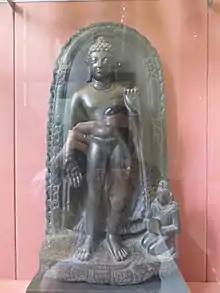Ye Dharma Hetu
Ye dharmā hetu (Sanskrit: ये धर्मा हेतु), is a famous Sanskrit dhāraṇī widely used in ancient times, and is often found carved on chaityas, images, or placed within chaityas.[1][2]

It is often used in Sanskrit, but is also found in Canonical Pali texts (Mahāvaggapāli PTS Vinaya Vol 1, pg 40).
It is referred to as the Dependent Origination Dhāraṇī.
These words were used by the Arahat Assaji (Skr: Aśvajit) when asked about the teaching of the Buddha. On the spot Sariputta (Skt: Śāriputra) attained the first Path (Sotāpatti) and later told them to his friend Moggallāna (Skt: Maudgalyayana) who also attained. They then went to the Buddha, along with 500 of their disciples, and asked to become his disciples.[3]
Original Sanskrit text
ये धर्मा हेतु-प्रभवा हेतुं तेषां तथागतो ह्यवदत्
तेषां च यो निरोध एवं वादी महाश्रमण
Transliterations
In Roman transliteration this dhāraṇī is variously transliterated, depending on the language it was written in. In Sanskrit it appears as:
ye dharmā hetuprabhavā
hetuṃ teṣāṃ tathāgato hy avadat,
teṣāṃ ca yo nirodha
evaṃvādī mahāśramaṇaḥ
In Pāḷi:
ye dhammā hetuppabhavā tesaṁ hetuṁ tathāgato āha,
tesaṃ ca yo nirodho evaṁvādī mahāsamaṇo.
Meaning
The meaning is:
Of those phenomena which arise from causes:
Those causes have been taught by the Tathāgata (Buddha),
And their cessation too - thus proclaims the Great Ascetic.
Pali version
Ye Dharma Hetu has been found in Pali Canon of Tripitaka as shown in Maha Vag section of Vinaya Pitaka at Verse No. 68 with the same meaning as sanskrit version as shown here:[4]
ye dhammā hetuppabhavā
tesaṃ hetuṃ tathāgato (āha)
tesañca yo nirodho
evaṃvādī mahāsamaṇoti.
The Pāḷi commentaries take the first line as pointing to suffering (dukkha), the second to its cause (samudaya) and the third to its cessation (nirodha).
Miniature Chaityas
The mantra has been widely used. It has been used at Sarnath, Tirhut, Kanari Copperplate, Tagoung, Sherghatti, near Gaya, Allahabad column, Sanchi etc.
On Buddha images
The mantra was often also carved below the images of the Buddha. A Buddhist screen (parikara) and accompanying Buddha image is now preserved at Museum of Fine Arts, Boston. While the objects were found in South India, the mantra is given in north Indian 8-9th century script, perhaps originating from the Pala region.[5]
Malaysia Inscriptions
The Bukit Meriam inscription from Kedah includes two additional lines. The inscription is now in the Indian Museum, Calcutta. Other similar inscriptions were found in the Kedah region.[6]
ये धर्मा हेतु-प्रभवा हेतुं तेषां तथागतो ह्यवदत्
तेषां च यो निरोध एवं वादी महाश्रमण
अज्ञानाच्चीयते कर्म जन्मनः कर्म कारणम्
ज्ञानान्नचीयते कर्म कर्माभावान्न जायते
Ye dharmma hetuprabhavā hetun-teṣān-Tathāgata āha,
teṣān-ca yo nirodha evam-vādi Mahāśramaṇaḥ
Ajñānāc-cīyate karmma, janmanaḥ karmma kāraṇam
jñānān-na cīyate karmma, karmmābhāvān-na jāyate.
The additional lines can be translated as
Through ignorance karma is accumulated, the cause of birth is karma.
Through knowledge karma is not accumulated. Through absence of karma, one is not reborn.
Inscriptions in Pallava scripts found in Thailand
Ye Dharma Hetu also found in Thailand including the stupa peak found in 1927 from Nakhon Pathom [7] along with a wall of Phra Pathom Chedi and a shrine in Phra Pathom chedi found in 1963,[8][9] a brick found in 1963 from Chorakhesamphan township, U Thong district of Suphanburi,[10] stone inscriptions found in 1964 [11][12] and the stone inscription found in 1980 from Srithep Archeological site.[13] All of them have been inscribed in Pallava scripts of Pali language dated 12th Buddhist century (the 7th Century in common era). Furthermore, there are Sanskrit version of Ye Dharma Hetu inscribed in Pallava scripts in clay amulets found in 1989 from an archaeological site in Yarang district of Pattani dated 12th Buddhist century (7th Century in common era).[14][15]
See also
- Om Mani Padme Hum
- Ashtamangala
- Buddhism
- Great Compassion Mantra – Expanded Compassion of Om Mani Padma Hum
- Heart sutra
- Karandavyuha Sutra
- Mani stone
- Mantra
- Samsara
- Shurangama Mantra – Expanded Protective Power of Om Mani Padma Hum
References
- "A New Document of Indian Painting Pratapaditya Pal". The Journal of the Royal Asiatic Society of Great Britain and Ireland. Royal Asiatic Society of Great Britain and Ireland (No. 3/4): 103–111. Oct 1965. JSTOR 25202861.
- On the miniature chaityas, Lieut.-Col. Sykes, Journal of the Royal Asiatic Society, Volume 16, By Royal Asiatic Society of Great Britain and Ireland,, University Press, 1856
- Text and Translation of their story: http://www.ancient-buddhist-texts.net/Texts-and-Translations/Mahakhandhako/41-Sariputta-Moggallana.htm
- "PaliRoman Vol.4". 84000.org.
- Jan Fontein, A Buddhist Altarpiece from South India, MFA Bulletin, Vol. 78 (1980), pp. 4-21, Museum of Fine Arts, Boston
- The Malay Peninsula: Crossroads of the Maritime Silk-Road (100 Bc-1300 Ad), by Michel Jacq-Hergoualc’h, BRILL, 2002. p. 213
- "ฐานข้อมูลจารึกในประเทศไทย | จารึกเยธมฺมาฯ ๒ บนสถูปศิลา".
- "ฐานข้อมูลจารึกในประเทศไทย | จารึกเยธมฺมาฯ ๑ (ระเบียงด้านขวาองค์พระปฐมเจดีย์)".
- "ฐานข้อมูลจารึกในประเทศไทย | จารึกเยธมฺมาฯ ๓ (หน้าศาลเจ้าฯ)".
- "ฐานข้อมูลจารึกในประเทศไทย | จารึกเยธมฺมาฯ บนแผ่นอิฐ (สุพรรณบุรี)".
- "ฐานข้อมูลจารึกในประเทศไทย | จารึกเยธมฺมาฯ ๔ (พระองค์ภาณุฯ ๑)".
- "ฐานข้อมูลจารึกในประเทศไทย | จารึกเยธมฺมาฯ ๕ (พระองค์ภาณุฯ ๒)".
- "ฐานข้อมูลจารึกในประเทศไทย | จารึกเยธมฺมาฯ เมืองศรีเทพ".
- "ฐานข้อมูลจารึกในประเทศไทย | จารึกเยธมฺมาฯ บนพระสถูปพิมพ์ดินดิบเมืองยะรัง (แบบมีรูปสถูปองค์เดียว) แบบที่ ๑".
- "ฐานข้อมูลจารึกในประเทศไทย | จารึกเยธมฺมาฯ บนพระสถูปพิมพ์ดินดิบเมืองยะรัง (แบบมีรูปสถูปองค์เดียว) แบบที่ ๒".
